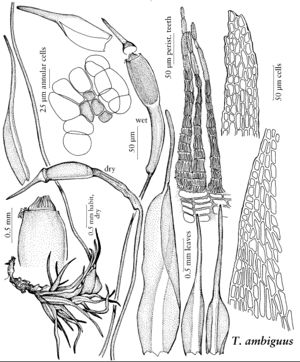Trematodon ambiguus
Flora 2: 88. 1819,.
Leaves ovate-lanceolate to short-subulate from an ovate or obovate base, serrulate at apex; costa excurrent or at least filling the leaf apex. Seta long, 10–30 mm. Capsule inclined, curved; neck as long as urn, long-cylindric, strumose at base; peristome teeth 2-fid or long-perforate, not fragile, commonly persistent; annulus compound, revoluble.
Phenology: Capsules mature late summer–fall.
Habitat: Soil, humus
Elevation: low to moderate, rarely high elevations
Distribution
Greenland, B.C., N.B., Nfld. and Labr., N.S., Ont., P.E.I., Que., Alaska, Maine, Md., Mass., Mich., Minn., N.H., N.Y., Pa., Vt., Va., Wis., Central America, Europe, Asia (China, Japan).
Discussion
The urn and capsule neck of Trematodon ambiguus and of T. longicollis are the same length in moist material, but the spore sac is relatively small in T. longicollis. The base of the urn collapses in dried specimens of the latter species, making its neck appear 2(–3) times as long as the urn.
Selected References
None.
